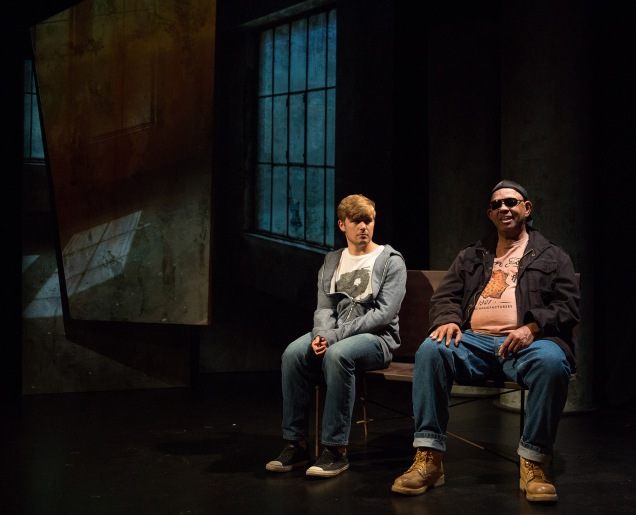
The word epic is so misused. It can be applied to, for instance, a migraine headache, or the feat of eating the most hot dogs in a competition at the county fair. Epic originally meant a long heroic poem, told in elevated style, The Iliad, for example. But epic has also been used to describe other works of art; Bertoldt Brecht wrote some epic plays. So, for our theatrical purposes here, let’s define epic as a work of unusual scope and length that deals with serious matters of great import. Certainly, Shakespeare’s cycle of plays about the House of Lancaster (Henry the Fourth Parts I and II; Henry the Fifth) can be called epic. Wagner’s Der Ring des Nibelungen is a monumental work, a cycle of four lengthy operas usually performed in four days.
Peter Brook’s 1985 adaptation of the Sanskrit epic, the Mahabharata, was first performed in French in a quarry outside of Avignon. The performance consisted of three parts, which took nine hours, eleven counting the breaks. In 1987, Brook later translated it in to English for a performance produced in Zurich. The only other production I know of that took a whole day to experience is The Western Stage’s extraordinarily fine production, East of Eden. Adapted by Alan Cook, the Steinbeck masterpiece was crafted into three three-act plays. They could be seen in three consecutive evenings or in one day—morning, afternoon and night. It is to this day the greatest piece of theatre I have ever seen.

With this lengthy introduction, I mean to place playwright Murray Mednick’s magnum opus, The Gary Plays, in appropriate context. The Gary Plays are not as sweeping in scope or performance as the Mahabharata or East of Eden. Mednick’s script consists of three parts, each with two distinct plays. Part I—Tirade for Three introduces a man named Gary (Jeff LeBeau), a middle-aged, out-of-work actor mired in an existential crisis. Goaded by a chorus consisting of a sympathetic man (Derek Manson), and a harsh, acerbic woman, (Amanda Weier), Gray spews venom and angst. Essentially components of his subconscious, the two badger, cajole and, rarely, encourage Gary, for whom life is the shits. He hasn’t had a job in a year and his agent says nobody knows him. He carries a lot more of life’s woes, but the key to it all is the death of his troubled, beloved son, shot down by nobody knows who for a reason nobody knows why. The style of this very short play is presentational, visually sparse, and performed with minimal movement in ten extremely short “acts.” It is a curtain raiser, immediately followed by Girl on a Bed.

Girl on a Bed opens up the action, and the style of acting shifts to something more realistic, much of it conceived as takes in the continuing movie that is Gary’s life. Scenes are announced by the chorus in script terms such as “EXTERIOR— STREET—DAY.” The chorus is still there weighing in when necessary, but other characters are autonomous, and not necessarily a product of Gary’s mind. The style is episodic, with characters revealed in shifts of time backward and forward. It gives nothing away to say that the audience sees the girl in the title, Laura (Laura Liguori), for the first time as she lays dead on a makeshift gurney representing a bed. Laura, as revealed in subsequent scenes, is a smart, beautiful girl of seventeen who lives in a home from hell with a harridan mother, Monica (Barbara Schofield), and a feckless father, Charles (Carl J. Johnson). Told so often that she is worthless and has no future, she becomes convinced of it. No one can help her; not the school counselor, Mrs. Williams (Peggy Ann Blow) nor her best friend, Rena (Sandra Kate Burck). She falls into the bad company of career junkie, Rondell (Phillip C. Curry), and that of a slick, well dressed, Latino named Antonio (Peggy Ann Blow), who is death incarnate. Antonio exploits her beauty in the worst of ways, confirming her own sense of worthlessness.

Laura’s connection to Gary and to Gary’s son, Danny (Josh Trant) occurs outside an AA meeting where Danny is struck by her beauty. As the action shifts back into Gary’s consciousness, the audience is introduced to his bitter, first wife, Gloria (Laura Richardson), and also to his impatient, had-it-up-to-here second wife, Marcia (Ms. Weier).

Directed with a sure hand by Guy Zimmerman, the cast, headed by the excellent Jeff LeBeau, is uniformly superb, each character rendered in rich, nuanced detail. Produced by Open Fist Theatre Company, the show is handsomely mounted with a minimalist, open-stage set by scenic designer Jeff Rack, lit with great subtly by lighting designer Dan Reed, and enhanced by the superb projections designed by Hana S. Kim. The extraordinary sound design by John Zalewski underscores the entire play, often with such extreme subtly that it is almost subliminal. Costumes by designer Kharen Zeunert fully support characters and action.
The Gary Plays, crafted and refined over decades by Murray Mednick, with the participation of many collaborators, is, judging by Part I, an undeniable accomplishment. This is a triumph in all its aspects, drama at its finest. But, some might whine, it is such a downer; it is so resolutely grim. To those I say, there is plenty of wry humor, and besides, Oedipus is comedy? Long Day’s Journey into Night is a laugh fest? Hamlet is fun?
Time is short and these comments are late. See this production before it is gone. It runs for two more weeks. Parts I, II, and III can be seen on Thursdays, Fridays and Saturdays, respectively, and the entire cycle on Sundays at 12 noon, 3pm and 7pm. at Atwater Village Theatre, 3269 Casitas Avenue in Los Angeles.

One thought on ““The Gary Plays-Part I” at Atwater Village Theatre”